A thread, commonly known as a screw thread, is a helical structure that wraps around a cylindrical or conical surface. It allows rotational motion to be converted into linear movement. Threads are essential in engineering for joining parts, creating movement, and transmitting force.
History and Importance of Threads in Engineering
Threads have been integral to mechanical engineering for centuries. The concept of the thread dates back to ancient times when it was used for basic fastening and lifting applications. As industrial manufacturing developed, standardized thread forms were introduced to ensure compatibility and interchangeability. Today, threads are critical in virtually every engineering sector, from aerospace to automotive industries. They ensure strong, removable connections and enable precision motion control.

Types of Thread Applications
Threads serve various purposes depending on the engineering requirements. The most common thread applications include:
Fastening Threads: These are used to hold two or more components together securely. Bolts and nuts are classic examples of fastening threads. They are commonly found in machinery, vehicles, and construction projects due to their strength and ease of assembly.
Movement Threads: These threads convert rotational motion into linear motion. Lead screws in machines and jackscrews in heavy equipment are good examples. Their precise design allows them to translate rotation into smooth, controlled movement, making them vital for mechanical systems requiring accuracy.
Transport Threads: Often found in conveyor systems and screw conveyors, these threads help transport materials or fluids. Their continuous spiral allows substances to move along a path with controlled force, making them useful in industries like agriculture and manufacturing.
Geometry and Design of Threads
Thread geometry plays a crucial role in determining its performance and suitability for various applications. Each parameter influences how threads engage, transfer force, and maintain structural integrity. Let’s explore the critical geometric parameters and tools used to measure threads.
Geometric Parameters of a Thread
The following geometric parameters define the shape and behavior of a thread:
Major Diameter: The largest diameter of a thread, measured across the tops of the external threads or the bottoms of internal threads. It determines the overall size and strength of the threaded part.
Minor Diameter: The smallest diameter, measured across the roots of the external thread or the tops of the internal thread. It defines the thickness of the material at the core of the screw or bolt.
Pitch Diameter (Effective Diameter): The diameter of an imaginary cylinder passing through the thread's flanks. It is essential for ensuring fit and engagement between mating threads, affecting how tightly they mesh.
Pitch: The axial distance between corresponding points on adjacent threads. A larger pitch allows more rapid movement per rotation, while a smaller pitch provides finer control and higher mechanical advantage.
Lead: The distance a thread advances in one full turn. On single-start threads, lead equals the pitch, but on multi-start threads, the lead is a multiple of the pitch.
Thread Starts: Refers to the number of individual threads on a screw. A single-start thread has one continuous helical groove, while multi-start threads provide quicker linear motion per rotation.
Helix Angle: The angle formed between the thread's helix and a line perpendicular to the axis of the thread. A steeper helix angle reduces friction but can reduce holding power.
Thread Angle: The angle formed between adjacent flanks of a thread. This affects how force is distributed and impacts the thread’s efficiency in transferring loads.
Tooth Angle: The shape and angle of the individual thread teeth, which vary based on the thread’s design and purpose. Tooth angles can be trapezoidal, square, or triangular, influencing the thread’s strength and friction properties.
Measuring Tools for Threads
Accurate thread measurement is essential to ensure compatibility between mating parts. Two primary tools used for this purpose are:
Caliper: A versatile tool for measuring the major and minor diameters of both male (external) and female (internal) threads. Its precision allows engineers to measure thread size quickly and accurately.
Pitch Gauge: A specialized tool designed to measure the distance between thread crests. It is crucial for identifying the pitch of the thread and is used for both metric and imperial thread types.
Identifying Threads
Accurate thread identification is crucial for proper component selection and system compatibility. Follow these steps to identify threads:
Steps to Identify Threads
1. Male vs. Female Threads
Male threads: External ridges on bolts, screws, or pipes.
Female threads: Internal grooves in nuts, holes, or fittings.
Visual inspection suffices; gender doesn't affect function but determines mating components.
2. Tapered vs. Parallel Threads
Parallel threads maintain constant diameter along length.
Tapered threads decrease in diameter towards end.
Use calipers to confirm: parallel threads contact full length, tapered threads rock.
3. Measuring Thread Pitch
Employ pitch gauge to determine distance between thread crests.
For imperial threads, count threads per inch (TPI).
For metric threads, measure distance between crests in millimeters.
4. Measuring Thread Size
Thread size measurement depends on thread type:
| Thread Type | Measurement Method |
| Pipe Threads | Compare to nominal size profile |
| Non-Pipe Threads | Measure outside diameter with caliper |
5. Designating Thread Type Standard
Compare measurements to standardized tables:
NPT/NPTF for American tapered pipe threads
BSP for British standard pipe threads
Metric for international standard threads
UN/UNF for unified national threads
Thread Standards and Specifications
In engineering, thread standards and specifications ensure compatibility, interchangeability, and precision across different systems and industries. Each standard defines the thread’s geometry, pitch, and tolerance. Here, we will discuss the most widely used standards, including ISO metric threads, Unified threads, British standard threads, and American pipe thread standards.
ISO Metric Threads (M)
The ISO metric thread is the most common thread standard globally. It uses metric measurements for both diameter and pitch, simplifying standardization across regions.
Thread Profile and Dimensions: ISO metric threads have a 60-degree V-shaped profile, defined by the nominal diameter and pitch. Both dimensions are measured in millimeters.
Coarse and Fine Pitch Series: The coarse pitch series (e.g., M10 × 1.5) is used in general-purpose applications, providing easier manufacturing. Fine pitch series (e.g., M10 × 1.0) are used when tighter fit and precision are required.
Tolerance Classes and Fits: ISO metric threads are divided into tolerance classes, such as 6g and 6H, determining the degree of clearance or interference. Coarser tolerances offer looser fits, while finer tolerances provide tighter fits.
Unified Thread Standard (UNC/UNF)
The Unified Thread Standard (UTS) is widely used in the U.S., Canada, and parts of the U.K. It provides measurements in inches and is similar to ISO metric threads in its use of coarse and fine pitch series.
Thread Profile and Dimensions: The UTS thread has a 60-degree V-profile, measured in inches. It includes both coarse (UNC) and fine (UNF) threads.
Coarse and Fine Pitch Series: UNC threads, like ¼”-20 UNC, are used for general fastening applications, while UNF threads, such as ¼”-28 UNF, are preferred for precision and strength in specific industries.
Tolerance Classes and Fits: UTS offers various tolerance classes, with commonly used classes including Class 1 (loose fit), Class 2 (standard), and Class 3 (tight fit).
British Standard Threads
British threads are a legacy system, still widely used in the U.K. and Commonwealth countries. These threads include Whitworth, Fine, and Pipe threads.
Whitworth Threads (BSW): The British Standard Whitworth (BSW) thread has a 55-degree thread angle. It is used for general-purpose fasteners, especially in older machinery.
British Standard Fine Threads (BSF): Similar to BSW but with a finer pitch, BSF threads provide stronger connections in applications subject to vibration, like automotive and aerospace components.
British Standard Pipe Threads (BSP): BSP threads are widely used for pipe fittings. BSPP (parallel) threads require an external seal, while BSPT (tapered) threads self-seal through wedging.
American Pipe Thread Standards
The American National Standard for pipe threads includes both NPT and NPTF types, designed for sealing applications.
Scope and Differences of Various Thread Standards
Different thread standards are not always compatible, as they vary in pitch, thread angle, and fit. ISO metric threads follow a universal system using metric units, while Unified threads and British threads use imperial measurements. Pipe thread standards like NPT and BSP also differ in their approach to sealing and fitment, further complicating compatibility.
Other International and Regional Standards
Several countries maintain their own thread standards for national industries. These include:
JIS (Japanese Industrial Standards): Japan’s JIS threads follow a similar approach to ISO metric standards but may differ slightly in pitch and application.
DIN (German Institute for Standardization): Germany’s DIN standards are closely aligned with ISO standards, providing thread specifications across industries from automotive to manufacturing.
GOST (Russian State Standard): The Russian GOST standard includes both metric and inch-based threads, heavily used in the country’s engineering and manufacturing sectors.
Summary Table of Key Thread Standards
| Standard | Region | Thread Angle | Measurement Units | Typical Applications |
| ISO Metric (M) | Global | 60° | Metric | General fasteners, machinery |
| Unified (UNC/UNF) | U.S., Canada | 60° | Inches | Fasteners, precision machinery |
| Whitworth (BSW/BSF) | U.K. | 55° | Inches | Older machinery, automotive |
| British Pipe (BSP) | U.K., Global | 55° | Inches | Pipe fittings, plumbing |
| NPT/NPTF | U.S. | 60° | Inches | Pipe fittings, fuel systems |
| JIS | Japan | 60° | Metric | Machinery, automotive |
| DIN | Germany | 60° | Metric | Automotive, industrial machinery |
| GOST | Russia | 60°/55° | Metric/Inches | Various, national industries |
Types of Threads
Threads come in various forms, each designed for specific engineering applications. Understanding the different types of threads is essential for selecting the right one for your project. Let’s explore common thread types based on direction, profile, and standard.
Right-Hand and Left-Hand Threads

Threads can be categorized based on the direction they turn to engage.
Right-Hand (RH) Threads: These are the most common type of threads. They tighten when rotated clockwise. Almost all general-purpose fasteners, such as screws and bolts, use RH threads for ease of use.
Left-Hand (LH) Threads: These threads tighten when turned counterclockwise. LH threads are used in situations where clockwise rotation could cause a part to loosen, such as in certain mechanical assemblies like bicycle pedals or specific automotive parts.
Thread Profiles
Thread profiles describe the shape of the threads and influence their strength, efficiency, and function.

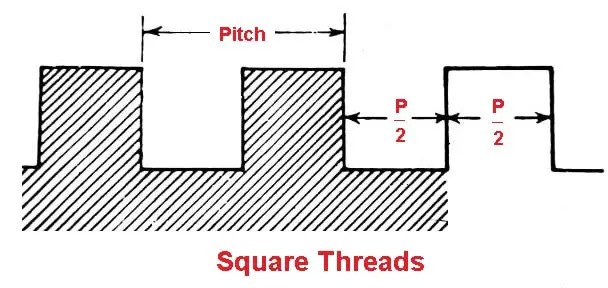
Square Threads: Square threads are efficient in power transmission, with minimal friction. They are often used in jackscrews, lead screws, and other heavy-duty mechanical devices.

Acme Threads: A modified form of square threads, Acme threads offer greater strength and are easier to manufacture. They are used in applications requiring heavy loads, such as machine tools and valves.
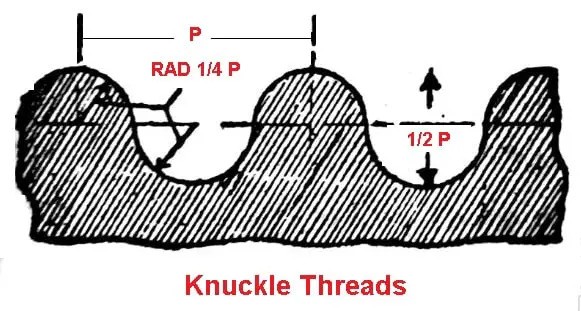
Knuckle Threads: Known for their rounded crests and roots, knuckle threads are designed to withstand rough use and are ideal for situations where debris or damage is common, such as in railway couplings or bottle caps.
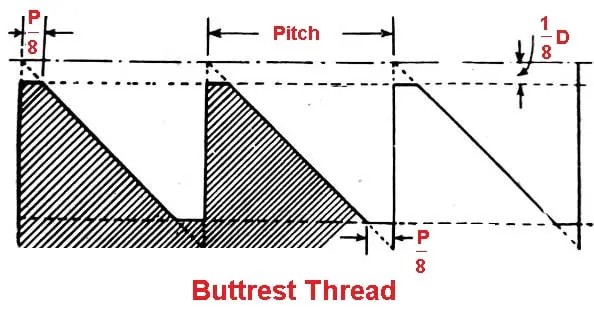

Tapered and Parallel Threads
Threads can also be classified by how their diameter changes along the length.
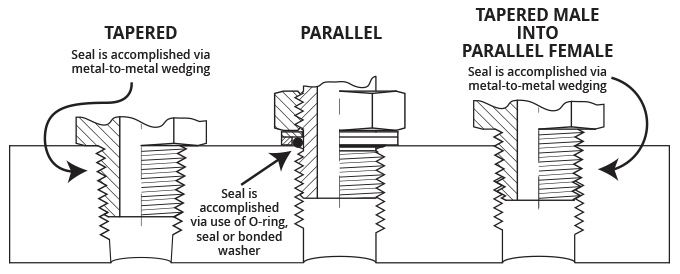
Taper Threads: These threads gradually decrease in diameter towards the end, creating a wedge that forms a seal. Tapered threads are common in pipe fittings and are self-sealing at low pressures. Examples include NPT (National Pipe Thread) and BSPT (British Standard Pipe Tapered).
Parallel Threads: Parallel threads maintain a constant diameter throughout. They require additional sealing methods, such as o-rings or thread tape, for fluid-tight connections. Common types include BSPP (British Standard Pipe Parallel) and NPTF (National Pipe Tapered Fuel).
Special Thread Types
Several standards provide specific threads for use in various industries, with notable examples being:
Unified National Threads (UNC, UNF, UNS): Commonly used in the U.S. and Canada, Unified threads are measured in inches. UNC threads (coarse) are used for general-purpose fastening, while UNF threads (fine) are preferred in high-strength applications. UNS threads are non-standard threads tailored for specific needs.
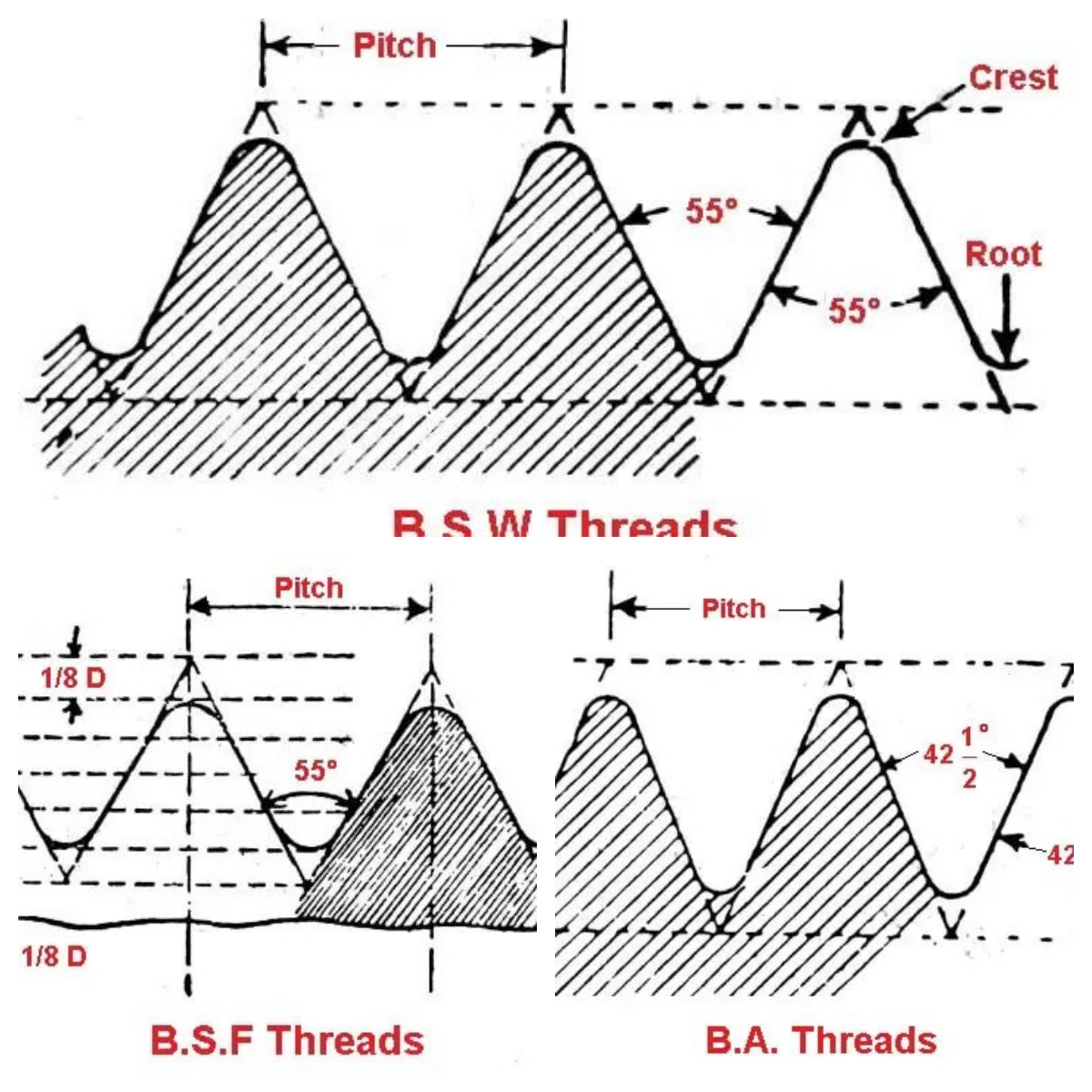
British Standard Threads (BSW, BSF, BSP): British Standard Whitworth (BSW) threads are used primarily in older machinery. British Standard Fine (BSF) threads provide stronger, finer connections and are used in vibration-prone environments. British Standard Pipe (BSP) threads are essential for pipe fittings in plumbing and gas systems, including both parallel (BSPP) and tapered (BSPT) forms.
Summary Table of Thread Types
| Thread Type | Profile | Applications |
| Right-Hand (RH) Threads | Clockwise | General-purpose fasteners |
| Left-Hand (LH) Threads | Counterclockwise | Parts prone to loosening under rotation |
| V-Shaped Threads | Triangular | Fastening, general machinery |
| Square Threads | Square | Power transmission, jacks, heavy machinery |
| Acme Threads | Trapezoidal | Heavy loads, machine tools |
| Trapezoidal Threads | Trapezoidal | Power transmission, European machinery |
| Knuckle Threads | Rounded | Railway couplings, bottle caps |
| Buttress Threads | Asymmetrical | Clamping devices, power presses |
| Worm Threads | Helical | Worm gears, right-angle power transmission |
| Taper Threads | Wedge-sealing | Pipe fittings (NPT, BSPT) |
| Parallel Threads | Constant diameter | Pipe fittings requiring external sealing |
| Unified National Threads | Inch-based | Fasteners, precision machinery |
| British Standard Threads | Inch-based | Pipe fittings, older machinery |
Thread Manufacturing Methods
The production of threads involves various techniques, each offering unique advantages for specific applications and materials. Here's an overview of the primary thread manufacturing methods:
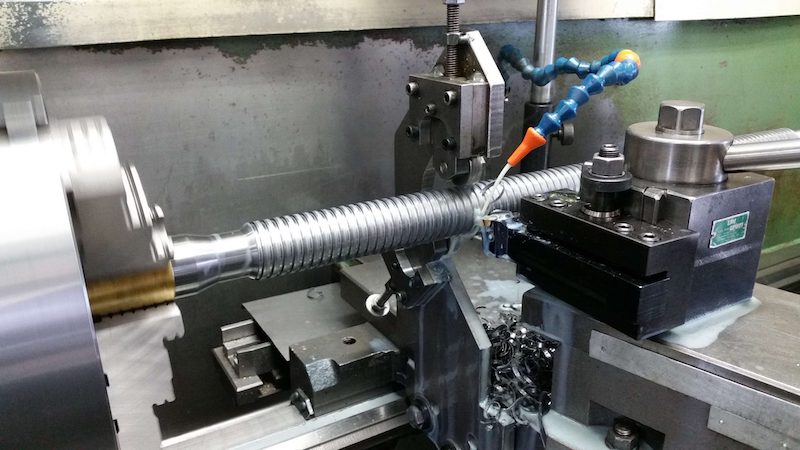
Thread Cutting (Taps and Dies)
Thread cutting remains a widely used method for creating both internal and external threads:
Advantages:
Suitable for small-scale production
Applicable to a wide range of materials
Relatively low initial tooling cost
Limitations:
Thread Rolling
Thread rolling forms threads through plastic deformation of the workpiece:
Benefits:
Drawbacks:
Thread Grinding
Thread grinding uses abrasive wheels to produce high-precision threads:
Key features:
Exceptional accuracy and surface finish
Suitable for threading after heat treatment
Capable of producing complex thread forms
Considerations:
Thread Milling
Thread milling employs rotating cutting tools to generate threads:
Advantages:
Capable of producing large diameter threads
Minimal tool pressure, ideal for thin-walled parts
Can create both right-hand and left-hand threads with same tool
Limitations:
3D Printing and Additive Manufacturing
Emerging technologies offer new possibilities for thread production:
Potential benefits:
Challenges:
Factors Affecting Thread Performance
Thread performance is influenced by various factors that determine its strength, durability, and reliability in engineering applications. From material selection to environmental considerations, understanding these factors is crucial for ensuring optimal thread performance. Below are key factors that affect thread performance.
Material Selection
Thread performance heavily depends on material properties:
Strength: Determines load-bearing capacity
Ductility: Affects thread formation and resistance to stripping
Corrosion resistance: Crucial for longevity in harsh environments
Surface Treatments and Coatings
Surface treatments improve the longevity and functionality of threads by reducing wear, corrosion, and galling. Common treatments include:
Zinc plating: Protects threads from corrosion and enhances their lifespan.
Black oxide coating: Provides mild corrosion resistance and enhances aesthetics.
Phosphating: Improves lubrication retention, making it useful in high-friction applications.
Anodizing: Commonly used for aluminum threads, it increases corrosion resistance and wear strength.
These treatments help threads perform reliably in harsh environments or high-wear applications.
Lubrication and Friction
Proper lubrication reduces friction during assembly and prevents galling or seizing, especially in high-load applications. Lubrication:
Reduces wear: Helps minimize damage caused by repeated tightening and loosening.
Improves torque control: Ensures even load distribution across threads, preventing over-tightening.
Thread lubricants can include oils, greases, or anti-seize compounds depending on the application’s specific requirements.
Environmental Factors
Threads are often exposed to varying environmental conditions, which affect their performance over time. Key factors include:
Temperature: High temperatures can cause material expansion and impact thread strength. Low temperatures can make some materials brittle.
Corrosion: Threads exposed to moisture, chemicals, or salt can corrode, weakening their structure over time.
Vibration: Continuous vibration can loosen threaded connections, leading to failure. Locking mechanisms like thread lockers or lock nuts can help mitigate this.
Addressing these environmental challenges is essential for maintaining the integrity of threaded connections.
Assembly and Tightening Methods
The method used to assemble and tighten threads significantly affects their performance. Key methods include:
Torque control: Applying the correct torque ensures threads are neither over- nor under-tightened, maintaining their integrity.
Preload tension: Proper preload reduces the risk of loosening under dynamic loads and ensures load distribution across the thread profile.
Fastening tools: Tools such as torque wrenches provide precision tightening, reducing the likelihood of thread failure.
Using correct assembly techniques enhances the durability and strength of threaded connections.
Load Types and Their Impact on Thread Strength
Threads are subjected to different load types, and each type affects the performance of the thread differently:
Static loads: Applied steadily over time, they generally do not cause thread failure unless the load exceeds the material's yield strength.
Dynamic loads: Vary over time and can cause threads to loosen or fatigue if not properly designed.
Fatigue loads: Repeated loading and unloading cycles weaken threads over time, leading to failure. Materials with higher fatigue resistance are preferred in such applications.
Understanding the load conditions ensures the right thread type and material are selected for the intended application.
Sealing Performance Requirements
In many applications, threads are required to provide a seal, especially in fluid or gas systems. Tapered threads like NPT and BSPT offer self-sealing properties by creating a tight fit as they are tightened. For threads that do not seal on their own (e.g., parallel threads like BSPP), additional seals such as o-rings or thread tape are required to prevent leaks.
| Thread Type | Sealing Ability | Applications |
| NPT Threads | Self-sealing | Pipe fittings, fluid systems |
| BSPT Threads | Self-sealing | Gas and fluid applications |
| BSPP Threads | Requires additional sealing (o-ring or tape) | Plumbing, low-pressure systems |
Addressing sealing requirements is crucial in ensuring fluid-tight connections in engineering applications.
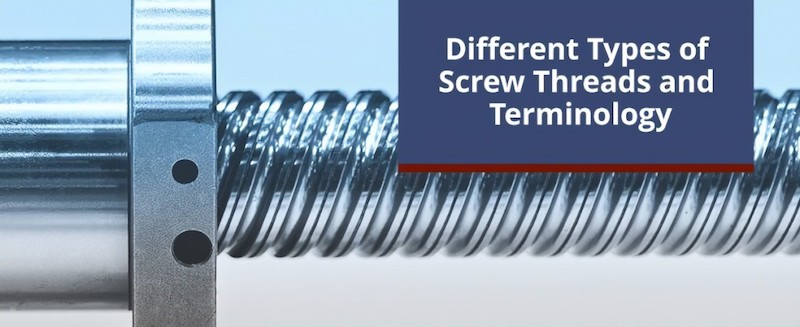
Applications of Threads in Engineering
Threads play a crucial role in various engineering applications, providing essential functions across multiple industries. Their versatility and efficiency make them indispensable components in modern engineering.
Fasteners
Threaded fasteners form the backbone of mechanical assemblies:
Bolts: High-strength connections in structural applications
Screws: Versatile fastening for a wide range of materials
Nuts: Provide secure, adjustable clamping force
These components enable easy assembly, disassembly, and maintenance of engineered systems.
Power Transmission
Threads excel in converting rotary motion to linear motion:
Their efficiency and accuracy make threads ideal for power transmission applications.
Fluid and Gas Sealing
Threaded connections are vital in fluid handling systems:
Pipe fittings: Secure, leak-proof joints in plumbing and industrial piping
Valves: Precise flow control in hydraulic and pneumatic systems
Tapered threads often provide self-sealing properties, enhancing system integrity.
Positioning and Adjustment
Threads enable fine adjustment in precision instruments:
Their ability to translate small rotations into minute linear movements is unparalleled.
Specific Industry Applications
| Industry | Application | Thread Type |
| Aerospace | High-strength fasteners | UNF, Metric fine |
| Automotive | Engine components | Metric, UNF |
| Medical Devices | Implant fixation | Custom, fine pitch |
| Oil & Gas | Pressure-tight connections | NPT, API |
Case Studies
High-Strength Bolted Connections in Bridge Construction
Challenge: Joining massive structural elements
Solution: Large diameter, high-strength bolts with UNC threads
Result: Durable, fatigue-resistant connections capable of withstanding dynamic loads
Precision Lead Screw in CNC Machines
Challenge: Accurate positioning of cutting tools
Solution: Ground, multi-start trapezoidal threads with anti-backlash nuts
Result: Submicron positioning accuracy and smooth motion control
Self-Sealing Pipe Connections in High-Pressure Systems
Challenge: Leak-free joints in hydraulic systems
Solution: NPTF tapered threads with controlled interference fit
Result: Reliable, metal-to-metal seals without additional sealing compounds
Thread Failure Modes and Prevention
Understanding thread failure modes is crucial for designing reliable and safe threaded connections. This section explores common failure modes, their causes, and preventive measures.
Common Failure Modes
Threaded components can fail in various ways:
Stripping: Thread deformation under excessive load
Shearing: Complete separation of threads due to extreme force
Galling: Surface damage from adhesive wear between mating threads
Seizing: Threads lock together, preventing disassembly
Fatigue: Gradual crack growth under cyclic loading
Stress Corrosion Cracking: Combination of tensile stress and corrosive environment
Causes of Thread Failures
| Cause | Description | Common in |
| Wear | Gradual material loss from friction | Frequently assembled joints |
| Corrosion | Chemical degradation of thread material | Exposed or humid environments |
| Fatigue | Repeated stress cycles leading to crack formation | Vibrating or cyclically loaded components |
| Overload | Exceeding thread's load-bearing capacity | Improperly tightened fasteners |
| Improper Assembly | Cross-threading or over-tightening | Manual assembly processes |
Preventive Measures
To mitigate thread failures:
Proper material selection based on environmental conditions and load requirements
Application of appropriate surface treatments or coatings
Use of thread-locking compounds for vibration resistance
Implementation of correct lubrication practices
Adherence to specified torque values during assembly
Proper Thread Selection and Design
Optimize thread performance through:
Selecting appropriate thread profile for the application
Considering load distribution and stress concentration factors
Evaluating environmental factors (temperature, corrosion potential)
Determining optimal thread engagement length
Choosing suitable tolerance classes for mating components
Quality Control and Inspection
Implement robust quality measures:
Dimensional inspection using precision gauges and measuring instruments
Non-destructive testing methods (e.g., ultrasonic, magnetic particle) for critical components
Periodic inspection and maintenance schedules for threaded assemblies
Documentation and traceability of thread manufacturing processes
Training programs for assembly personnel to ensure proper installation techniques
Endnots
Threads are essential in engineering, used for fastening, movement, and power transmission. They ensure strong, reliable connections in mechanical systems.
Proper selection, design, and quality control of threads are crucial to avoid failures and improve performance in various applications.
Exploring thread standards, materials, and manufacturing techniques can greatly enhance understanding of thread applications.
For more details, check industry standards and resources to ensure optimal performance in your engineering projects.





















